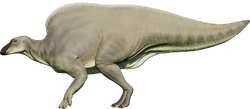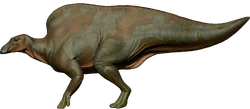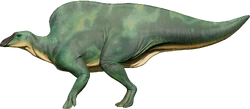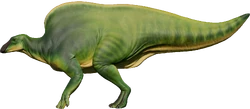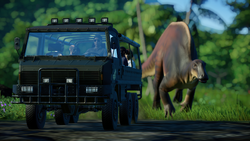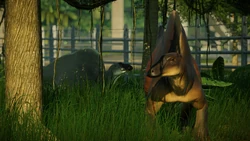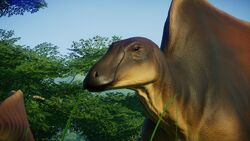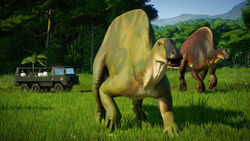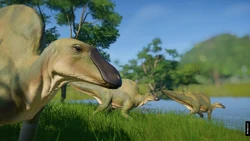Template:Infobox incubation
| I've just heard from the lab. We have a new Ouranosaurus. You did it. |
Ouranosaurus is a genus of ornithopod dinosaur that originated from Early Cretaceous Africa. A basal hadrosaur, Ouranosaurus also possesses a hump-like sail on its back, similar to that of the Acrocanthosaurus.
Upon completion of the Claire's Sanctuary story missions, Ouranosaurus becomes available in the main campaign by progressing through the Entertainment Division on Isla Sorna, where its fossils can subsequently be excavated in the Tegama Beds.
History
Ouranosaurus was recreated by InGen for Jurassic World on Isla Nublar. Several members of the species remained alive on the island in the aftermath of the park's abandonment in 2015, and were encountered by the survivors of Camp Cretaceous; Jurassic World's resident summer camp.[1]
Description
Ouranosaurus is a medium-sized ornithopod with hadrosaur-like snout and tall neural spines on its back. Its base genome is a gradient color scheme that goes from dark brown to brick red with a light cream underbelly.
Behaviour
Ouranosaurus is a very social animal that can live in a herd with up to twelve individuals, and twenty dinosaurs of varying species. It can not live without a pair otherwise it will break out of its enclosure and cause guest injuries. Unlike Iguanodon, it cannot defend itself and thus should not be mixed with predatory dinosaurs.
In addition to eating from Ground Herbivore Feeders, with the Claire's Sanctuary expansion pack, Ouranosaurus benefit from Rotten Wood in a Ground Paleofeeder, with a secondary preference for Conifers.
Paleontology
Ouranosaurus was originally believed to have been an iguanodontid, but recent studies suggest that it may be a basal hadrosaur. Compared to Iguanodon, the skull of Ouranosaurus is longer and flatter, with more similarities to hadrosaurs such as Edmontosaurus. Another feature of the skull is a pair of horns above its eyes, which may have been used as a display. Other similar horns can be found on Albertosaurus and Maiasaura.
The most famous feature of Ouranosaurus is the tall neural spines. At first, these spines were thought to support a display sail like that of the Spinosaurus, but recent analysis suggests they are too thick to support a sail and resemble vertebrae of bison and camels. Most modern reconstructions, therefore, give it a fatty hump instead.
Paleoecology
Ouranosaurus fossils are found in the Elrhaz Formation in Niger where the environment consisted of fluvial sandstones and sand dunes. Here it lived alongside the spinosaur Suchomimus, the sauropod Nigersaurus, the ornithomimosaur Afromimus, as well as the ornithopods Lurdusaurus and Elrhazosaurus. The main predators to Ouranosaurus were the theropods Kryptops, Suchomimus, and Eocarcharia, the latter being an ancestor of Carcharodontosaurus. As well as these land-based threats, there was also a large crocodylomorph; named Sarcosuchus in the water.
Available genomes
| Fossil icon | Dig site | Quality | Number available |
|---|---|---|---|
| Tegama Beds | 2 6 12 8 |
Skins
![]() Rainforest: Nublar North Challenge Mode Any Difficulty Unlock
Rainforest: Nublar North Challenge Mode Any Difficulty Unlock
Gallery
References
- ↑ Lueras, L., Kreamer, S., Spielberg, S., Trevorrow, C., Marshall, F. (Executive Producers). (2020–present). Jurassic World Camp Cretaceous [TV series]. Universal Pictures; DreamWorks Animation Television.
External links
- Ouranosaurus on Wikipedia


